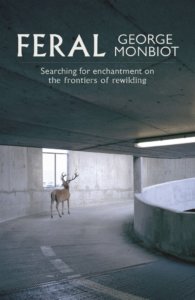This blog’s recent writing competition was to write a review of George Monbiot’s book Feral.
The entries were judged by John Riutta, The Well-read Naturalist, Ian Carter and myself.
The winning entry by Kerrie Gardner was posted on Sunday. Two more entries were highly commended and this is the first of them, by Tom Rigby.
 Tom Rigby is an organic dairy farmer just North of the Lancashire/Cheshire border very keen to stop the spread of bTB from Cheshire to Lancashire. He is coordinator of the Sheep Dip Sufferers Support Group and chair of NFU’s Organic Forum.
Tom Rigby is an organic dairy farmer just North of the Lancashire/Cheshire border very keen to stop the spread of bTB from Cheshire to Lancashire. He is coordinator of the Sheep Dip Sufferers Support Group and chair of NFU’s Organic Forum.
Tom’s review of Feral:
To anyone unfamiliar with the author there are three things you need to know at the outset.
Firstly he writes well; from first bite of the cockchafer grub in the very first paragraph until the final farewell from the dolphin calf in the last I was hooked and drawn into his world.
Secondly some of his views are controversial and this book is no exception; there were times, such as where he quoted tributes to the feral child-beating murderer Raoul Moat, I wanted to throw it away in disgust.
Thirdly he states many ‘facts’ which are not easy to verify; since much of his work is well-researched I was happy to take on trust that the major tree species in the UK became dominant because of their ability to withstand attack from a straight-tusked elephant but I imagine some readers may be more sceptical.
George lists over 30 of the most magnificent creatures to grace these islands in more recent times, the approximate date of their extinction in Britain and their suitability for reintroduction. This is assessed on a scale from 1 to 10 with fourteen of these being given a score of 8 or higher. Some of these such as beavers and wild boar are already here (although not without issues) while the Lynx is given a suitability score of 9. He does not dodge the more thorny issue of in whose backyard they are to be accommodated.
Chapters 9 and 11 are compulsory reading for anyone with an interest in the future of the uplands (and would possibly make a stand-alone pamphlet in their own right). The first of these, Sheepwrecked, describes the ecological impact he believes is being caused by grazing and the second, ‘How not to rewild’ makes the case that: “… rewilding must not be an imposition. If it happens, it should only be done with the consent and active engagement of the people who live on and benefit from the land”.
Sandwiched between the two, chapter 10 describes the time George spent living with a sheep farming family in Mid-Wales where he shows a begrugding admiration for those who try to make a living in the Cambrian mountains and a respect for their historic culture. However it is apparent George really doesn’t like sheep and struggles to understand why anyone else does either. Lost on him is the splendour of these noble animals which prompted Beatrix Potter to bequeath an entire fortune for the conservation of herds of hefted Swaledales as she believed their fell belonged to them and not to us.
In this book George offers a very personal view – none the worse for that and it would be unfair to criticise simply because of a different persuasion but as it has provoked much discussion about the future of hill farming (and may be the only book on hill farming some ever read) the weakness do need addressing.
It is wrong to assume hill farmers are there just by accident of history. For most it is because they have no desire to be anywhere else and they like things just the way they are (and millions of visitors to our National Parks every year seem to concur). The highly acclaimed film ‘Addicted to Sheep’ charting a year of a family delighted to have secured a tenancy on a farm in the North Pennines in the quest to breed the perfect sheep taps in to many of the same emotions George regards as the preserve of reverence for Nature Herself.
There are many good books on the subject which could usefully accompany Feral, for example Geoffrey Cole’s classic One Hundred Years of Hill Farming and more recent autobiographies by the Yorkshire Shepherdess Amanda Owen or BBC Countryfile’s Adam Henson. One way to assess how well an author understands sheep farming is if they recognise when shepherds’ health has been affected by organophosphates used in sheep dip (as these three authors do on pages 245, 40-41 and 136-138 respectively). Adam suspects “the authorities realized that they were poisoning a lot of farmers” which is bold statement from a BBC presenter wanting to keep his job but he is on solid ground. The problem first identified by a Kurdish-born neurologist working in Glasgow (later hounded out of the country), the saga of missing medical records and clandestine testing on our farmers by US chemical weapons personnel is scarcely known beyond those who experienced it but if such injustice had been inflicted on a peasant farming community anywhere else in the world George would probably have travelled to investigate and written about it with such a passion to leave Guardian readers foaming at the mouth with indignation. As it is UK’s sheep farmers have been left feeling marginalised and expendable.
I would recommend this book to anyone. It’s subtitle is ‘Searching for enchantment on the frontiers of rewilding’ and it certainly delivers on that. However as a basis for hard-headed policymaking it has its limitations. Any farmer reading it will probably make the necessary corrections as they read it but it really ought to come with a health warning: “this book may seriously damage your perspective”.
 Feral: searching for enchantment on the frontiers of rewilding by George Monbiot is published by by Allen Lane, Penguin Press.
Feral: searching for enchantment on the frontiers of rewilding by George Monbiot is published by by Allen Lane, Penguin Press.
My own review of the book is here.
Buy your copy of Feral from Blackwell’s and I will earn a little bit of money too!
[registration_form]
“Thirdly he states may ‘facts'”.
Think it will be a realy good book to read a lot of true words Mark
Well, he says a lot of good things throwing in odd ones that are doubtful such as doing away with animals as soya is so good.
doubtful if soya is much of a crop for most of UK and where he is so against animals as poor converters then there are really very few crops as an alternative on the poorer land or even better land where it is steep.
Of course, he ignores the fact? that there are many more birds where cattle are kept.
Let us not ignore the fact he makes loads of money by writing controversial articles.
As people become better off all the evidence is that the first thing that happens is they eat more meat.
Reading about him I really admire him but find lots of his views dubious but guess that is what he plans.
Tom, that’s an interesting and good review. Thanks.
Your points about the atrocious organo-phosphate scandal need to be heard far and wide.
Things were sort of OK once in those hills. It was called mixed farming supporting ‘hefted’ communities of working families, each with a home. That was one home, not two or three homes.
To be frank I find the subtitle of this book a bit self serving and a bit New Age touchy-feely.
Come on George, forget the ‘cockchafer grub, I’m eating it show’ and concentrate (like you’re good at) on rewilding the economy. We desperately need a land value tax in order to revitalise the countryside. Yes, that’s it: a trophic taxcade.